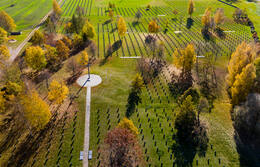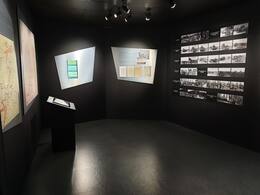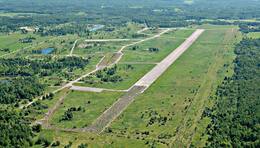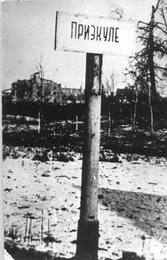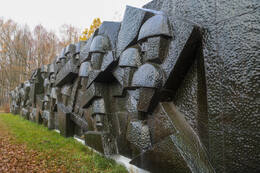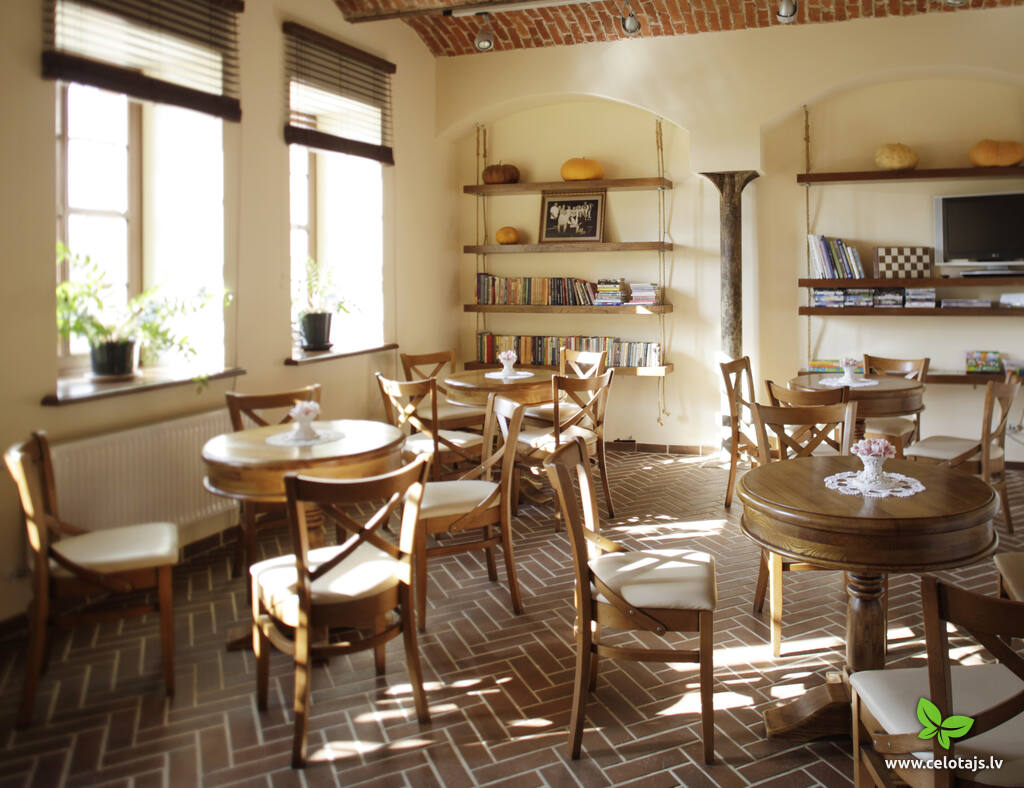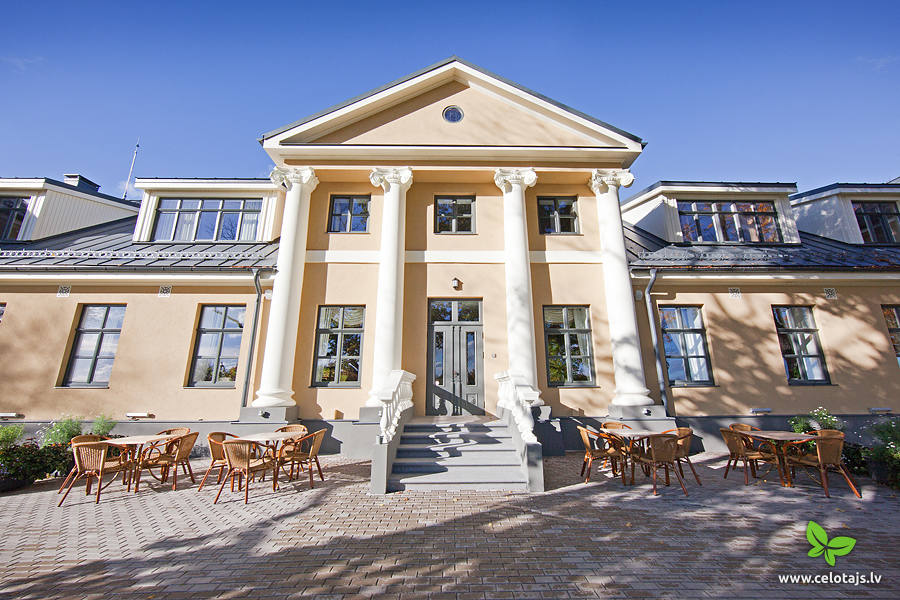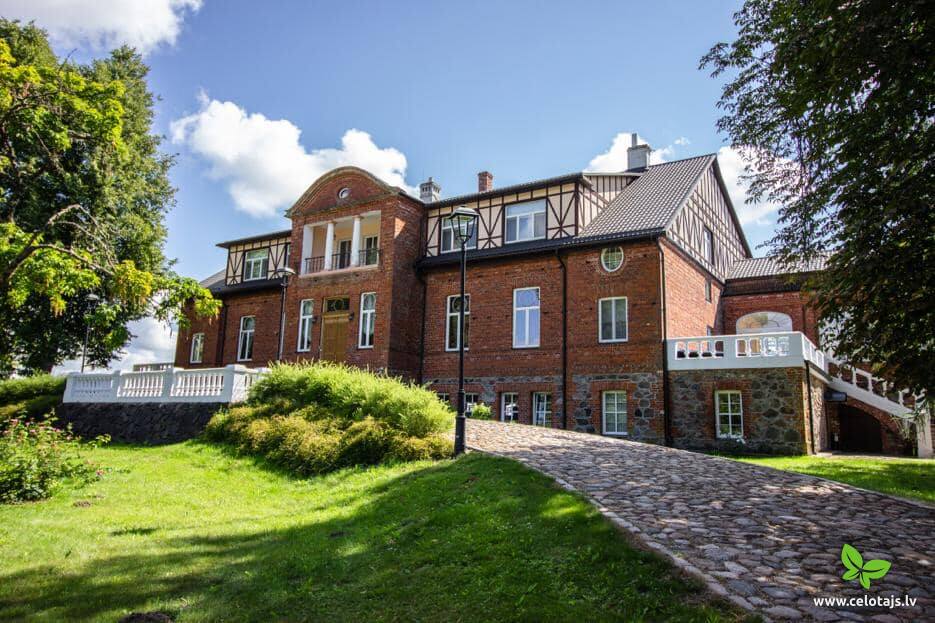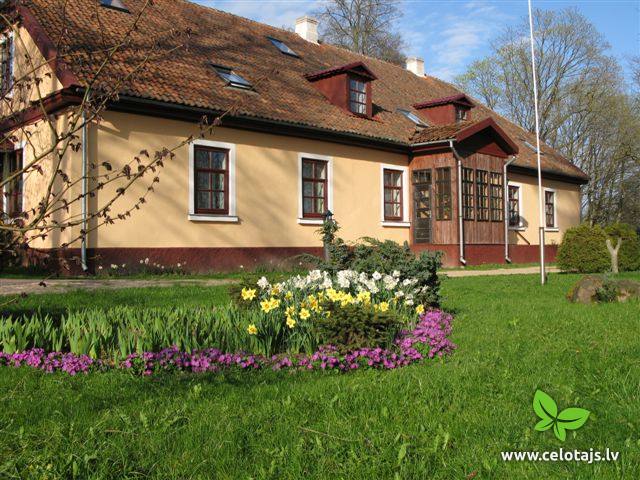Along the battlefields of Kurzeme Pocket to Soviet Heritage adventure in Dundaga
Day 2.
140 km
Saldus–Ezere–Vaiņode–Priekule–Skrunda
Practical info
- Driving distance: 140 km
- Due to distances and time, 4–5 of the listed sights can be visited on this day
- Visit Ezere local history repository “Muitas Nams” (“Customs House”) upon advance booking +371 29475438; +371 63842152
- Vaiņode air base can be only visited with a guide, bookings +371 29229743
- Guided excursions in Priekule and surroundings can be booked from the Priekule Tourist Information Centre +371 26132442. The length of the excursion is variable from 3 to 6 hours, depending on interest
Sights
Saldus German Soldiers' Cemetery
Saldus German soldier's cemetery is located on the Saldus-Ezere highway. Around 25,000 German soldiers, as well as some Latvian legionnaires, were reburied in the 8-hectare cemetery. Reburial has been taking place since 1997.
From May 1 to October 1, an exposition on the Battle of Kurzeme can be seen in the memorial room. During this period, the memorial room is open on weekdays from 9:00 a.m. to 5:00 p.m., on Saturdays and Sundays the cemetery also has a tour guide. The registers of soldiers buried in Saldus German soldiers' graves and fallen soldiers throughout Latvia are also available.
Ezere local history repository “Muitas Nams” (Customs House)
The Ezere Customs House is located in Ezere near the Saldus-Mažeikiai highway at the Latvian-Lithuanian border. The act of surrender of the German Army units ‘Kurzeme’ (Kurland) surrounded in the so-called ‘Courland Pocket’ was signed in this building on 8 May 1945. It is believed that World War II actually ended in Ezere. The customs house has an exhibit covering the events of the end of World War II and exhibits detailing the history of Ezere parish from ancient to modern days. In the morning of 7 May 1945, the commander of the Leningrad Front, Marshal L. Govorov, sent an ultimatum to the command of the army group ‘Kurzeme’ to lay down arms. The act of surrender was signed by the involved parties on May 8 and it detailed the procedure of surrender, weapons collection points, documents and information to be submitted and other practical measures.
Vaiņode air base
Vaiņode airfield still has 16 Soviet-era aircraft hangars and an 1800 m section of the once 2500 m long runway. The airfield can only be visited with a previous booking. Vaiņode airfield was established during the Latvian independence as one of the cradles of Latvian aviation and was later one of the largest military airfields in the Baltic States. In 1916, two hangars for German Army airships were built. Airships were used to gather intelligence and bomb the positions of the Russian Army. Later the city of Riga bought the airship hangars and used their roof structures to build the pavilions of the Riga Central Market. In May 1940, the 31st Fast Bomber Aviation Regiment of the Red Army moved to Vaiņode, and the construction of a standardized concrete slab runway began. At the end of the summer of 1944 the partially completed airfield was used by various German aviation units, however, at the end of World War II, the same airfield was used by the Red Army aviation units fighting the German Army group called ‘Kurzeme’. After World War II the Soviet Air Forces were stationed in Vaiņode until 1992.
Priekule Memorial Ensemble of Warrior’s Cemetery
The Priekule Memorial Ensemble of Warrior’s Cemetery is on the Liepāja-Priekule-Skoda road and is the largest burial site of Soviet soldiers of World War II in the Baltics. More than 23,000 Soviet soldiers are buried here. Operation Priekule was one of the fiercest battles in Kurzeme Fortress that took place from October 1944 to 21 February 1945. The Battle of Priekule in February 1945 lasted seven days and nights without interruption and had a lot of casualties on both sides. Until Priekule Warrior’s Cemetery was transformed into a memorial, the last monument of the outstanding Latvian sculptor K. Zāle (1888-1942) was located here to commemorate the independence battles in Aloja. Between 1974 and 1984, the 8 ha Priekule Warrior’s Cemetery was transformed into a memorial ensemble dedicated to those who fell in World War II. It was designed by the sculptor P. Zaļkalne, architects A. Zoldners and E. Salguss, and the dendrologist A. Lasis.
The centre of the memorial holds a 12 m tall statue called the ‘Motherland’, and names of the fallen are engraved on granite slabs. Until Latvia regained its independence, the Victory Day was widely celebrated every year on May 9.
Places to eat
Skrunda Manor Restaurant in Skrunda
Skrunda Manor is located on the bank of the River Venta, on the side of the Riga-Liepāja highway. The manor restaurant uses products grown in Latvia and produced by local farmers, offering its guests to taste original local dishes, such as carp croquettes with homemade rhubarb mayonnaise, pork belly with birch leaf syrup and celery, and a selection of ice cream made in the manor.
Bistro “Jumis” in Skrunda
The "Jumis" café is on the side of the Rīga-Liepāja highway (A9). The interior is finished in wood.
Latvian cuisine: Cottage cheese with herring and soured cream, farmer’s breakfast, mushroom soup, pork cooked in onions, sautéed liver, homemade steak haché, grilled pork ribs, potato pancakes, stuffed pancakes.
Special foods: The “Jumis” pot of ham.
Restaurant “Piena Muiža” in Sieksāte village
The saloon is in the restored mansion of the Sieksāte (Berghof) Estate, and there is a milk museum in the granary and the cheese-making building. Guests can try their hand at milking cows and at churning and tasting fresh butter.
Latvian cuisine: Rye bread, herring with cottage cheese, milk soup, boiled potatoes a la countryside with chives, sliced venison, pike-perch in cream, plaice with peas, potato pancakes with lingonberry jam.
Special foods: Piena Estate cheesecake, homemade egg liqueur.
There are limited lunch and dining options in Vaiņode–Priekule region. Meals can be pre-booked leismalite.lv/paest/ or packed lunch should be prepared in advance
Places to stay
Skrunda Manor in Skrunda
Skrunda Manor is located on the bank of the River Venta, on the side of the Riga-Liepāja highway. It is a hotel with 12 comfortable rooms, banquet halls, and conference rooms. The manor restaurant uses products grown in Latvia and produced by local farmers, offering its guests to taste original local dishes, such as carp croquettes with homemade rhubarb mayonnaise, pork belly with birch leaf syrup and celery, and a selection of ice cream made in the manor.
“Piena Muiža” in Sieksāte village
This restored historical estate has a luxurious hotel with 23 rooms and the Rose Saloon where dishes are offered from locally grown ingredients. Pamper yourself in the spa salon with milk baths and massages. There is a sauna with a fireplace hall, small pool, aromatic steam bath and sauna. Lovers of sauna rituals have access to a white countryside sauna and a black stone sauna. There are facilities for larger and smaller celebrations. There is an area for caravans, as well as tennis courts for athletes. Visit the Milk Museum to learn all about milk. You can try your hand at milking a cow and churning butter that you can taste after it is done. You can listen to a speaking little cow, Venta, who will talk about the origins of milk. Also resident on the state are deer, sheep and horses named Mia and Mara. The estate is surrounded by an apple orchard and park, with all trees labelled. Next door is the Garīki farm, where mushrooms are grown. It is also worth a visit. The estate is on the edge of the Southern Courlandian Highlands, offering beautiful views of the surrounding area.




